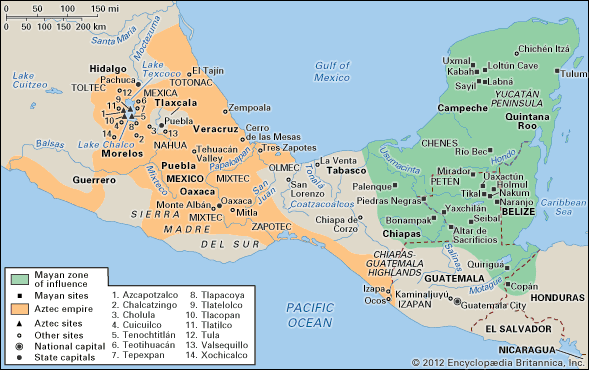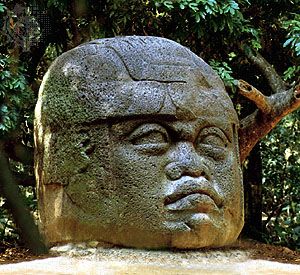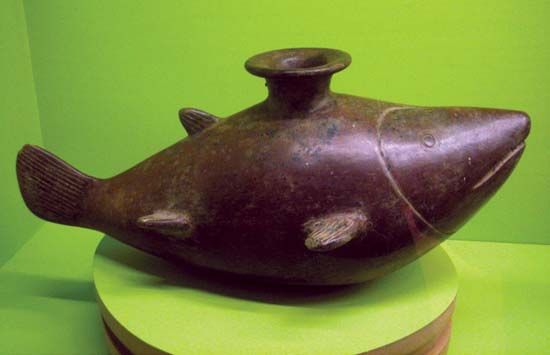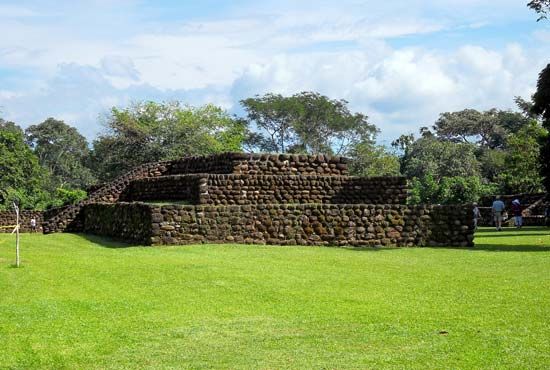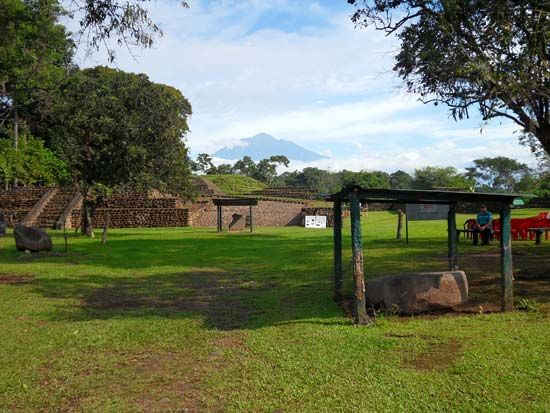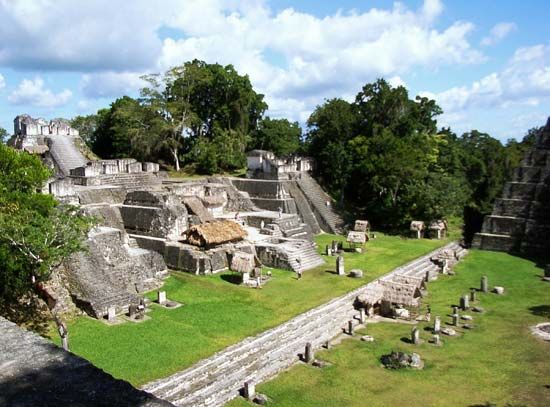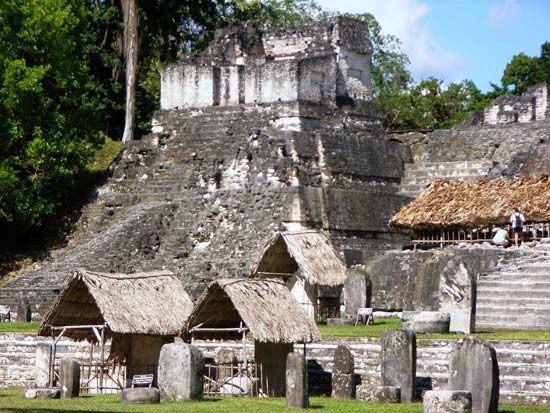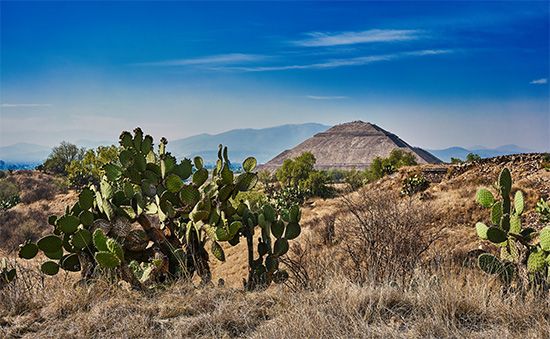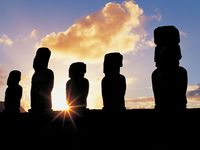Knowledge and belief
On the intellectual, ideological, and religious levels, although some diversity and certain elaborations occurred in some regions, there was a fundamental unity to the Meso-American area, the product of centuries of political and economic ties. The religion was polytheistic, with numerous gods specialized along the lines of human activities. There were gods for basic activities such as war, reproduction, and agriculture; cosmogenic gods who created the universe and invented human culture; and gods of craft groups, social classes, political systems, and their subdivisions. Gods were all-powerful and had to be constantly propitiated with offerings and sacrifices, a concept reaching its peak in personal bloodletting and human sacrifice. Certain gods, such as the god of rain (called Tlaloc in central Mexico), were found throughout the area. A fundamental concept was that of a quadripartite multilevel universe that, by 1519, had gone through five creations and four destructions. Meso-American religion heavily emphasized the astral bodies, particularly the Sun, the Moon, and Venus, and the observations of the movement of these bodies by the astronomer-priests were extraordinarily detailed and accurate. The major purpose of these observations was astrological, and the Meso-American priests had developed a number of time counts, or calendrical rounds, based in part on these observations. Two basic calendars, a 260-day divinatory calendar and one based on the solar year of 365 days, were found throughout the area.
One of the great intellectual achievements of Meso-American civilization was writing; in Postclassic times books were made from the inner bark of the paper-fig tree and used to record calendars, astronomical tables, dynastic history, taxes, and court records.
Religion was a pervasive force in Meso-American life, as the art demonstrates; and considerable surplus energy was devoted to it (e.g., temple construction, support of a numerous professional priesthood). Many writers have stated that the major focus of Meso-American culture was in this sphere. In fact, the contrast between Postclassic and Classic was in part based on the presumed even greater emphasis on religion in the art and architecture of the latter period.
The historical annals
The rise of the Aztec
A major characteristic of the Postclassic, in contrast to the Classic, is the abundant historical documentation. The Aztec record is particularly rich, and much of it is undoubtedly genuine, although there is always the possibility that records were rewritten or tampered with for political reasons. One of the functions of Meso-American writing was to record the succession and achievements of dynastic lines, and consequently it served as a validation of power. Virtually all of the dynasties of the local states recorded their history. A problem in the utilization of these documents, other than the low number of survivals, is the fact that many of them have strong mythological overtones. The Aztec themselves, for example, as creators of a great empire, explained their rise in part to the fact that they were the chosen people of the war god Huitzilopochtli and were the sustainers of the sun god Tonatiuh. They started their history as a poor, nomadic tribe from the north, who entered the Basin of Mexico, led by a magician-priest, and ultimately settled on the lake islands because of a series of astrological predictions and signs. They lived for a while as a subject people and then embarked on their destined role as conquerors and priests of the sun god. Virtually all historical traditions of local groups begin with a migration, a period of trials, and ultimate success—and some records even claim that the people were hunters and gatherers during the early part of their history.
On the northern frontier of Meso-America, in the arid Mexican Plateau, true hunters and gatherers, referred to as the “Chichimeca” by the civilized peoples, did actually reside in 1519. The name Chichimeca was frequently applied to the migrant groups. It is difficult to see how hunting and gathering bands could successfully invade areas of dense civilized populations; but agricultural groups, during periods of dynastic weakness, undoubtedly could. In fact, the term Chichimeca was also applied to agricultural but less civilized peoples (such as the Otomí in central Mexico) and thus connoted a lack of polish or a rustic life-style. Since the northwestern portion of Meso-America was occupied by such people and since they were Nahua in speech, the legends of periodic north–south migrations of invaders, though they may have a factual basis, probably refer to movements of agricultural rather than hunting and gathering peoples.
The histories of these invading groups take on a more convincing historical character after the legends of migration. In the Aztec case they record the founding of Tenochtitlán in 1325. By 1376 the Aztec had increased in numbers and prestige sufficiently to obtain a member of the ruling family of Culhuacan, a neighbouring state, to rule as their tlatoani, or king. His name was Acamapichtli. The Aztec at this time were paying tribute to another state, Azcapotzalco, on the lake shore; and they remained under this obligation through the reigns of his two successors, Huitzilhuitl (c. 1390–1415) and Chimalpopoca (1415–26). During the reign of Chimalpopoca, Maxtla, the ruler of Azcapotzalco, attempted to secure tighter control over subject states by replacing their tlatoanis with his own men. He succeeded in arranging the assassination of Chimalpopoca and the exile of Nezahualcóyotl, ruler of Texcoco, a state on the east shore of Lake Texcoco. In response to these acts, a coalition was formed between Nezahualcóyotl, Itzcóatl (Chimalpopoca’s successor), and another small state (Tlacopan), and the power of Azcapotzalco was broken.
A triple alliance was then formed between Tenochtitlán, Texcoco, and Tlacopan, which by 1519 resulted in the dominance of Aztec Tenochtitlán. Under the Aztec rulers Itzcóatl (1428–40), Montezuma I (1440–69), Axayacatl (1469–81), Tizoc (1481–86), Ahuitzotl (1486–1502), and Montezuma II (1502–20), and the two Texcocan rulers—Nezahualcóyotl (1431–72) and Nezahualpilli (1472–1516)—the triple alliance succeeded in conquering the vast domain described above. Tlacopan seems to have been relegated to an inferior political role early in the history. The records of the Aztec and neighbouring states in the Basin of Mexico between 1300 and 1519 are relatively free from mythological tales and have sufficient cross-referencing to present a reasonably clear picture of military events, dynastic succession, institutional changes, and economic development. The period from 1200 to 1300 is essentially one of migration legends of the dynasties of the various states, the historical traditions of which are discussed below.
The question of the Toltec
The historical traditions also state that these migrations were responsible, along with a series of natural disasters, for the collapse of a great empire ruled by a people called the Toltec from their capital of Tollan, or Tula. Many dynasties of the conquest period, not only in central Mexico but even as far afield as highland Guatemala and the Yucatán Peninsula, claimed descent from the Toltec, apparently as a result of their dispersion after the fall of Tula.
The traditions describe the Toltec as the first civilizers, the first city builders, and the originators of craft skills and astrological knowledge. The major questions are: Did the Toltec really exist as a people? Where was Tula? Did these people actually play the extraordinary political and cultural role ascribed to them? To begin with, the annals themselves are in fundamental disagreement with respect to dates and the lists of Toltec kings. There are at least three major chronologies of the Toltec Empire (see below table). The dates by Ixtlilxóchitl, a learned mestizo of the post-conquest period, place the Toltec well within the Classic period of Meso-American archaeology, but the others correlate them with the early portion of the Postclassic. Most writers favour the later dates, but this would mean that the Toltec were not the first civilized peoples in central Mexico, as they claim.
| Chronologies of the Toltec empire | |||||
|---|---|---|---|---|---|
| Ixtlilxóchitl | Anales de Cuauhtitlán | Codex Ramírez | |||
| Chalchiuhtlanetzin | 510–562 | Huetzin | 896–? | ||
| Ixtlilcuechahauac | 562–614 | Totepeuh | ?–887 | Mixcoatl | 900–947 |
| Huetzin | 614–666 | Ihuitimal | 887–923 | ||
| Totepeuh | 666–718 | Topiltzin | 923–947 | 980–999 | |
| Nacoxoc | 718–770 | Matlacxochitl | 947–983 | 1000–34 | |
| Mitl-tlacomihua | 770–829 | Nauhyotzin | 983–997 | 1034–49 | |
| Xihuiquenitzan | 829–833 | Matlaccoatzin | 997–1025 | 1049–77 | |
| Iztaccaltzin | 833–885 | Tlilcoatzin | 1025–46 | 1077–98 | |
| Topiltzin | 885–959 | Huemac | 1047–1122 | 1098–1168 | |
Adding further doubt to the veracity of the Toltec history is the admixture of myth and magic in the annals, not only at the beginning (which, like the histories of later dynasties, begins with a migration under a magician priest) but throughout the narrative. The ruler Topiltzin, for example, is also called Quetzalcóatl (the Nahua name for the Feathered Serpent god); he is opposed by Tezcatlipoca (also an Aztec god) and is driven out of Tula. He flees with his followers to the Gulf of Mexico and embarks on a raft of serpents. The story sounds like a duplicate of the cosmic myth or conflict between the two gods (see below Cosmogony and eschatology). Notably, the Maya in Yucatán had a tradition of a landing on the west coast made by foreigners, under a leader named Kukulcán (which is the Maya word for Feathered Serpent), who founded a city at Chichén Itzá and ruled over the Maya.
In spite of all the objections, the traditions of a great empire and of the city of Tula are so persistent that they must refer to some historical event and, indeed, have some archaeological support.

